Additive manufacturing
Influence of Temperature on AM Metal Powders using the GranuPack, the GranuDrum and the GranuCharge
In Additive Manufacturing (AM) processes, a three-dimensional object is created one superfine layer at a time. Therefore, the term Additive Manufacturing implies adding material to create the object...



Introduction
In Additive Manufacturing (AM) processes, a three-dimensional object is created one superfine layer at a time. Therefore, the term Additive Manufacturing implies adding material to create the object. By contrast, if an object is created by classical means, it is often necessary to remove material through milling, machining, etc…
However, despite AM is more economic than classical machining, in most case, only a small proportion of powder that is laid down in a build process is welded into a component. The rest is then unfused and consequently available for re-use. Nonetheless, powders properties should be the first consideration are they govern machine parameters. Indeed, if we consider the unfused powder as contaminated and not adapted for reuse, the cost of Additive Manufacturing will not be economic enough. Powder deterioration results in two phenomena:
- a) Products chemistry modification. Indeed, the main concern is to create solid structures comprised of the pure alloys. Therefore, we must avoid any kind of powder contamination such as oxides or nitrides.
- b) Mechanical properties changes, such as shape/morphology, Particle Size Distribution. In fact, those parameters are related to another key-parameters, which are powders flowability and spreadability. In other words, any modifications in the powder characteristics may result in a product that cannot be evenly distributed across the bed.
Regarding raw materials (or powders) characterisation, few relevant measurements methods are available in the market to answer this need. Indeed, the stress state and the flow field of the powder should be comparable in the measurement cell and in the process. Different recent publications have evidenced that the classical flowmeters are unable to give pertinent information about powder spreadability in powder-bed-based Additive Manufacturing.
In shear cell testers and classical rheometers, the existence of a compressive load is incompatible with the free surface flow used in AM devices.
With these information in mind, GranuTools has developed a workflow for powder characterisation for AM. Our main goal is to have one instrument per geometry that mimics accurately and precisely the process.
This workflow was used to understand and follow the evolution of the quality of a powder after several printing processes. First, several standard aluminium alloys (AlSi10Mg) were selected and placed for different durations at different thermal stresses (from 100 to 200°C). The powders spreadability (GranuDrum Instrument), the packing dynamics (GranuPack Instrument) and the electrostatic behaviour (GranuCharge Instrument) were then analysed. It has been proven that it is possible to monitor thermal degradation by analysing the ability of the powder to build-up electrical charge. Cohesion and packing dynamics measurements are well suited to follow powder quality. Indeed, on the one hand, a low Cohesive Index is observed for a powder easy to spread. On the other hand, a powder with a fast packing dynamic will yield a mechanical piece with a lower porosity in comparison with a product harder to pack.
Material Methods
Selected Powders
Three different aluminium alloys powders (AlSi10Mg) and one Stainless-Steel 316L sample with different particle size distribution were selected. They will be called sample A, B and C (the Samples grain size distribution were measured by Laser diffraction analysis / ISO 13320, these are the supplier data):
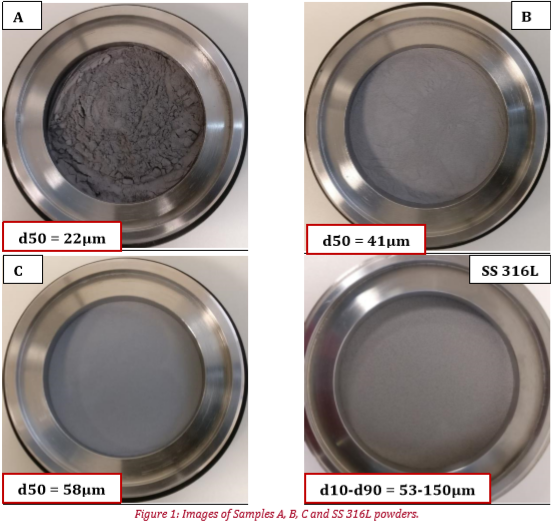
It is important to note that these powders were stocked in our lab during several months. Therefore, their properties may be slightly different than those communicated by the manufacturers.
Methods
Powders properties should be the first consideration, since they govern machine parameters. Indeed, if we consider the unfused powder as contaminated and not adapted for re-use, the cost of Additive Manufacturing will not be economic enough. For this purpose, three parameters will be investigated in this paper: powders spreadability, packing dynamic and electrostatics.
The spreadability is the homogeneity and “smoothness” of the powder bed after the recoater operation. This parameter is essential because a smooth surface is easier to print and gives better parts. This parameter will be investigate using the GranuDrum instrument with the Cohesive Index measurement.
Packing dynamic is the second key parameter, because, a powder with a fast packing, means a product will low porosity. Since, pores represent weaknesses within the material, they can act as crack initiation sites. This behaviour is measured with the GranuPack using the n1/2 values.
Powder electrostatics: The GranuCharge measures the ability of a powder to create electrostatic charges during a flow in contact with a selected material. The presence of electric charges in a powder induces cohesive forces leading to the formation of agglomerates. Therefore, the GranuCharge is able to predict the flowability deterioration during a processing, for example during the layer formation in additive manufacturing. Moreover, the result of a GranuCharge measurement is highly sensitive to grains surface state (oxidation, contaminants and roughness). Then, the ageing of a recycling powder can, be quantified precisely (± 0.5nC).
Spreadability Measurement: The GranuDrum
The GranuDrum instrument is an automated powder flowability measurement method based on the rotating drum principle. A horizontal cylinder with transparent sidewalls called drum is half filled with the sample of powder. The drum rotates around its axis at an angular velocity ranging from 2 rpm to 60 rpm. A CCD camera takes snapshots (30 to 100 images separated by 1s) for each angular velocity. The air/powder interface is detected on each snapshot with an edge detection algorithm. Afterwards, the average interface position and the fluctuations around this average position are computed. Then, for each rotating speed, the flowing angle (also known in the literature as ‘dynamic angle of repose’) αf is computed from the average interface position and the dynamic cohesive index σf is measured from the interface fluctuations.
LEARN MORE ABOUT THE GRANUDRUM
In general, a low value of the flowing angle αf corresponds to a good flowability. The flowing angle is influenced by a wide set of parameters: the friction between the grains, the shape of the grains, the cohesive forces (van der Waals, electrostatic and capillary forces) between the grains. The dynamic cohesive index σf is only related to the cohesive forces between the grains. A cohesive powder leads to an intermitted flow while a non-cohesive powder leads to a regular flow. Therefore, a dynamic cohesive index closes to zero corresponds to a non-cohesive powder. When the powder cohesiveness increases, the cohesive index increases accordingly.

In addition to the measurement of both the cohesive index σf and the flowing angle αf as a function of the rotating speed, the GranuDrum allows to measure the first avalanche angle and the powder aeration during the flow.
LEARN MORE ABOUT THE GRANUDRUM
Packing Dynamics Measurements
GranuPack bulk density, tapped density and Hausner ratio measurement (commonly named “taptap test”)
is very popular for powder characterization because of both the simplicity and the rapidity of the measurement. Moreover, the density and the ability of a powder to increase its density are important parameters for storage, transportation, caking, etc. The recommended procedure is defined in the pharmacopeia. This simple test has three major drawbacks.
First, the result of the measurement depends on the operator. Indeed, the filling method influences the initial powder volume. Secondly, the volume measurements by naked eyes induce strong errors on the results. Finally, with this simple method, we completely miss the compaction dynamics between the initial and the final measurements.
LEARN MORE ABOUT THE GRANUPACK
The GranuPack instrument is an automated and improved tapped density measurement method based on recent fundamental research results. The behaviour of the powder submitted to successive taps is analysed with an automatized device. The Hausner ratio Hr, the initial density ρ(0) and the final density after n taps ρ(n) are measured precisely. The tap number is commonly fixed at n=500.
Moreover, a dynamical parameter n1/2 and an extrapolation of the maximum density ρ(∞) are extracted from compaction curves. Additional indexes can be used but they are not presented in this report. The powder is placed in a metallic tube with a rigorous automated initialization process. Afterwards, a light hollow cylinder is placed on the top of the powder bed to keep the powder/air interface flat during the compaction process. The tube containing the powder sample rose up to a fixed height of ΔZ and performs free falls. The free fall height is generally fixed to ΔZ = 1mm or ΔZ = 3mm. The height h of the powder bed is measured automatically after each tap. From the height h, the volume V of the pile is computed.
LEARN MORE ABOUT THE GRANUPACK
As the powder mass m is known, the density ρ is evaluated and plotted after each tap. The density is the ratio between the mass m and the powder bed volume V.
With the GranuPack method, the results are reproducible with a small quantity of powder (typically 35 ml). The Hausner ratio Hr is related to the compaction ratio and is calculated by the equation Hr = ρ(500) / ρ(0), where ρ(0) is the initial bulk density and ρ(500) the tapped density computed obtained after 500 taps.
Electrostatic Measurements: The GranuCharge
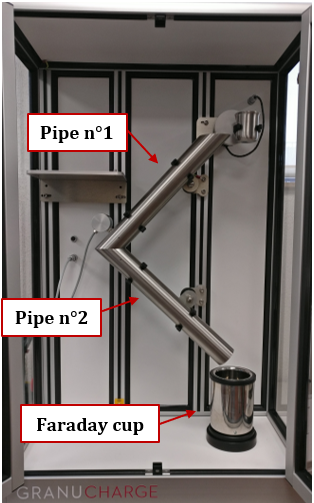
Electrostatic charges are created inside a powder during a flow. This apparition of electric charges is due to the triboelectric effect, which is a charge exchange at the contact between two solids.
LEARN MORE ABOUT THE GRANUCHARGE
During the flow of a powder inside a device (mixer, silo, conveyor, …), the triboelectric effect takes place at the contact between the grains and at the contact between the grains and the device. Therefore, the characteristics of the powder and the nature of the material used to build the device are important parameters.
The GranuCharge instrument measures automatically and precisely the quantity of electrostatic charges created inside a powder during a flow in contact with a selected material.
The powder sample flows inside a vibrating V-tube and fall in a Faraday cup connected to an electrometer. The electrometer measures the charge acquired by the powder during the flow inside the V-tube.
In order to obtain reproducible results, a rotating or a vibrating device is used to feed the V-tube regularly.

The triboelectric effect is a result in one object gaining electrons on its surface, and therefore becoming negatively charged, and another object losing electrons, thus, becoming positively charged. Which material becomes negative and which becomes positive depend on the relative tendencies of the materials involved to gain or lose electrons. Some materials have a greater tendency to gain electrons than others, in the same manner that others tend to lose electrons easier.
To represent these trends, the triboelectric series was developed (Table 1). It lists materials with tendency to charge positively and others with tendency to charge negatively. In the middle of the table are listed materials that do not show tendency to behave either way. However, this table only gives information about materials charging behaviour tendency. This is for this reason that the GranuCharge was developed: to give precise numerical values about powders charging behavior.
Experimental Results
In order to investigate thermal degradation, several experiments were carried out: The virgin samples were analysed at the same room humidity/temperature, i.e. 35.0 ± 1.5%RH and 21.0 ± 1.0°C with the GranuPack, GranuDrum and GranuCharge.
The samples were placed during one or two hours at 200°C. Once it is done, the powders are immediately analysed using the GranuDrum (samples will be desined as “hot”). The powder is afterwards placed in a container until it reaches ambient temperature. Finally, they were analysed using GranuDrum, GranuPack and GranuCharge (i.e. “cold”).
Spreadability
Experimental Protocol
Before the experiment, air relative humidity (RH, %) and temperature (°C) are recorded.
Once these steps are completed, the powder is poured inside the rotating drum cell, then experiment is started. The Cohesive Index is linked to the fluctuations of the interface (powder / air) position, and it only represents the three contact forces (Van der Waals, Capillary and Electrostatic). Therefore, the Cohesive Index quantify powder spreadability.
Results
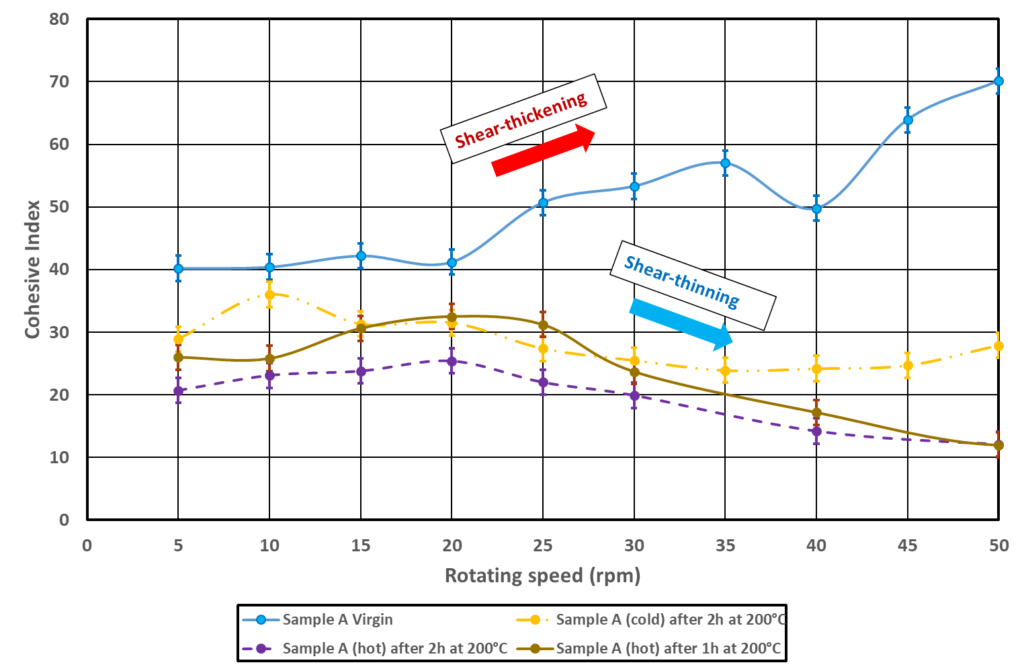

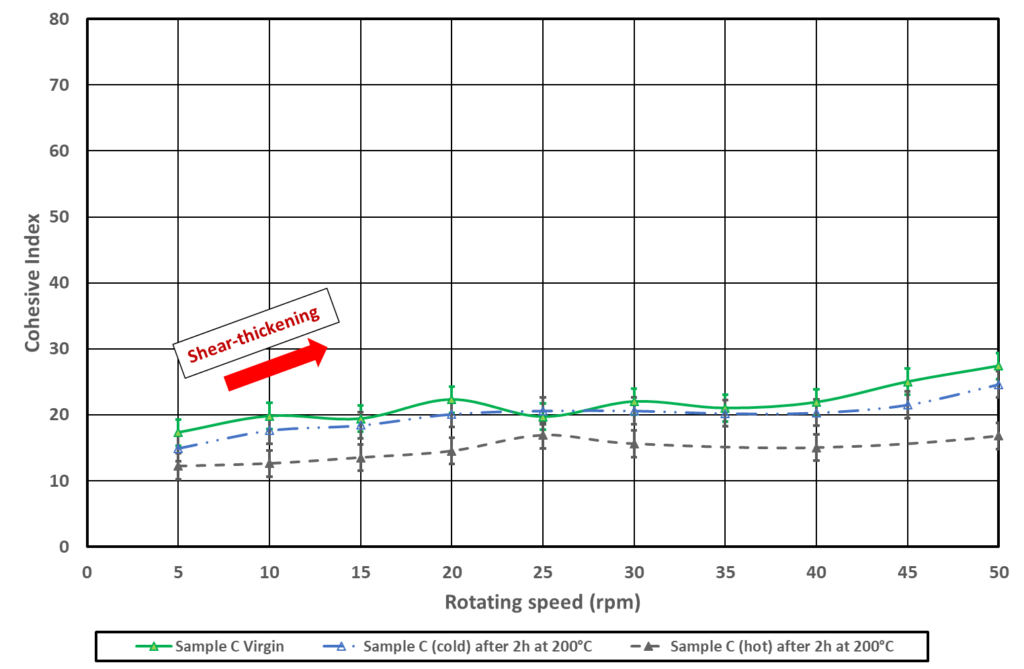

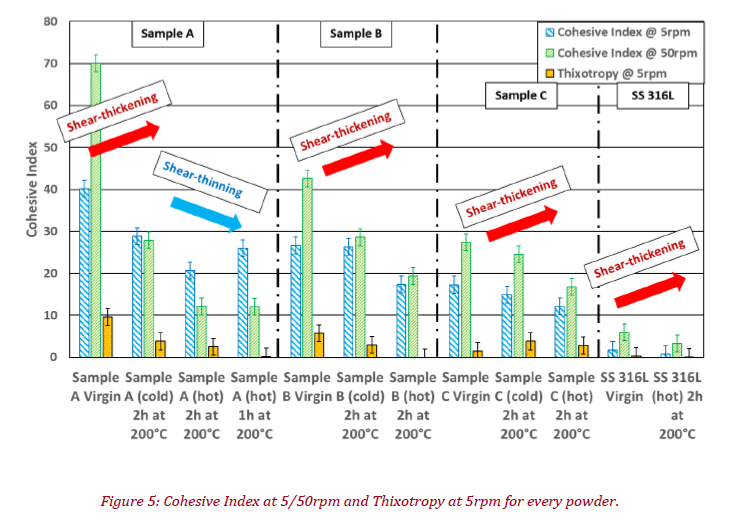
First of all, judging by the thixotropy parameters, it is possible to conclude that those products are not sensitive to agglomeration.
Those results are highly interesting, indeed, for sample A (and slightly sample B) the thermal stress completely change the powder rheological behavior, with a modification from shear-thickening to shear-thinning. Globally, every powder achieves a better spreadability (i.e. a lower Cohesive Index) when heated up and after being cooled down. Sample C and SS 316L are not highly affected by temperature and only show a shear-thickening behavior.
The effect of temperature seems also to be dependent on particles specific area. Indeed, the smaller the particles the more important the temperature influence. Additionally, the more the material thermal conductivity, the more the effect on temperature on it. Finally, working at high temperature seems to be a good choice with Aluminium alloys powders, because their spreadability increase. Even the cooled down sample achieve a better spreadability in comparison with the virgin powders.
Packing Dynamics
Experimental Protocol
For each experiment with the GranuPack, 500 taps were applied to the sample with a taps frequency of 1Hz and the measurement cell free-fall was 1 mm (∝ tap energy). The powder mass is recorded before each experiment. The sample is poured inside the measurement cell by following the software instructions (i.e. without user dependency). Measurements were repeated two times for evaluating reproducibility and the average value and standard deviation were considered.
LEARN MORE ABOUT THE GRANUPACK
Once the GranuPack analysis is done, the initial bulk density (ρ(0)), the final bulk density (at a number of taps, n = 500 ; i.e. ρ(500)), the Hausner ratio/Carr index (Hr/Cr), and two parameters linked to the compaction dynamics (n1/2 and τ) are recorded. The optimal density ρ(∞) is also displayed.
Results
Figure 6 and Figure 7 represents the full compaction curves (bulk densities versus number of tap) and n1/2 parameter/Hausner ratio. Error bars have been displayed on every curve and they were calculated using the average value and standard deviation calculated with the repeatability tests.
In terms of bulk densities for virgin powders, we can see that sample A is the lightest product and B and C achieve approximately the same values if error bars are taken into account (1.380g/ml). The Stainless-Steel 316L product, is, without surprise, the heaviest one (ρ(0) = 4.554g/ml). Regarding the tapped densities, SS 316L is still the heaviest powder (ρ(n) = 5.044g/ml), sample A comes in second position (ρ(n) = 1.668g/ml) followed by sample B (ρ(n) = 1.645g/ml). And sample C has the lowest one (ρ(n) = 1.581g/ml).
If the powder is heated up its Hausner ratio decreases. Nonetheless, this trend only occurs for sample B, C and SS 316L.
Indeed, for sample A due to error bars size it is impossible to conclude.
For the n1/2 parameter trends are more complicated to highlight. Indeed, for sample A and SS 316L, n1/2 decreases after 2 hours at 200°C, while it increases for powders B and C after thermal stress.
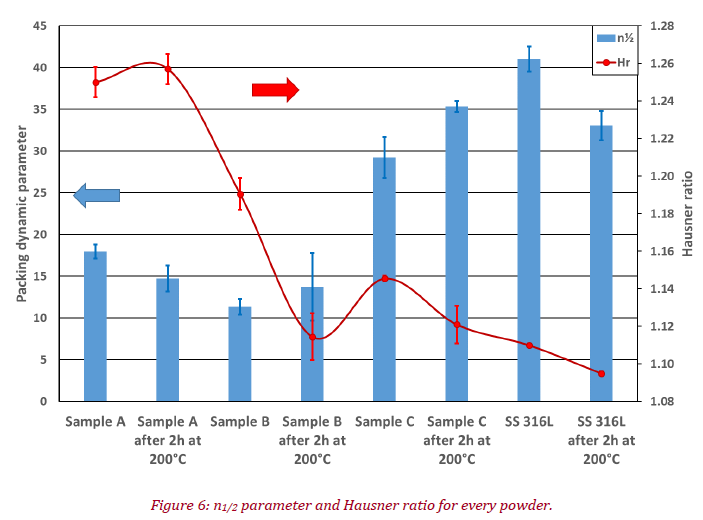
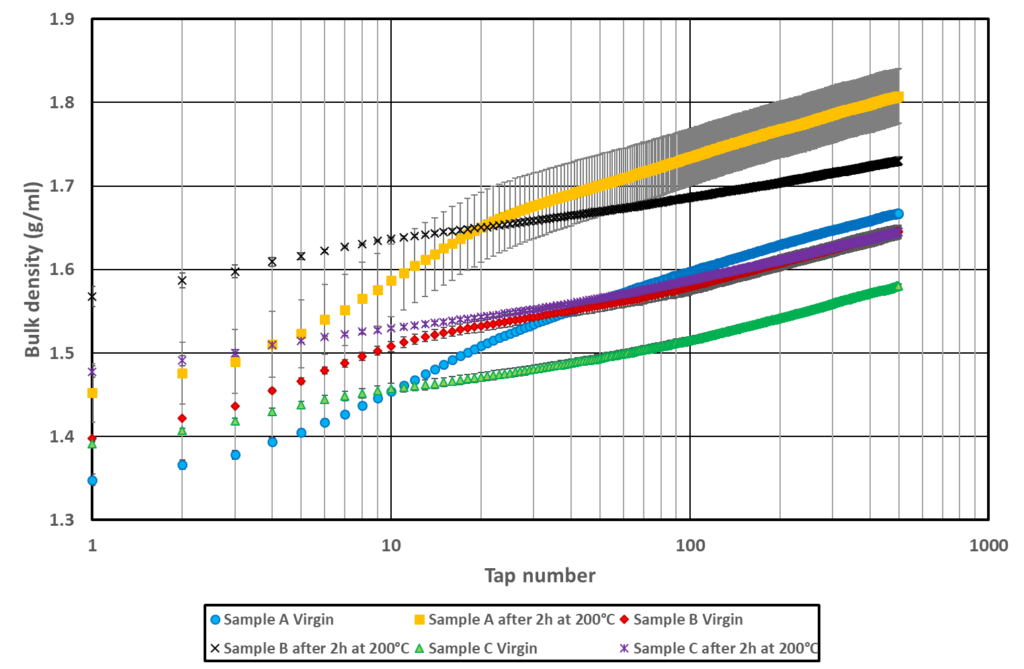.png)
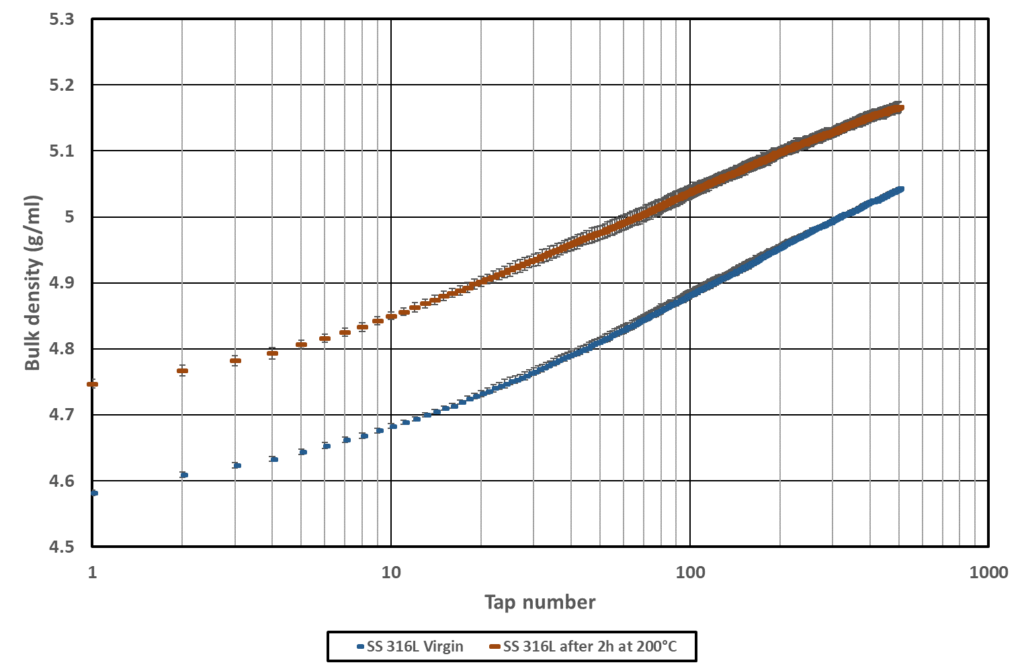.png)
| Sample Name | ρ(0) (g/ml) | σ ρ(0) | ρ(n) (g/ml) | σ ρ(n) | n1/2 | σ n1/2 | Hr | σ Hr | Cr | σ Cr | ρ∞ (g/ml) | σ ρ∞ |
|---|---|---|---|---|---|---|---|---|---|---|---|---|
| Sample A | 1.334 | 0.008 | 1.668 | 0.000 | 18.0 | 0.9 | 1.250 | 0.008 | 20.0 | 0.5 | 1.781 | 0.001 |
| Sample A after 2h at 200°C | 1.439 | 0.036 | 1.808 | 0.033 | 14.8 | 1.5 | 1.257 | 0.008 | 20.4 | 0.5 | 1.926 | 0.029 |
| Sample B | 1.382 | 0.003 | 1.645 | 0.008 | 11.4 | 1.0 | 1.191 | 0.009 | 16.0 | 0.6 | 1.738 | 0.008 |
| Sample B after 2h at 200°C | 1.552 | 0.013 | 1.730 | 0.004 | 13.8 | 4.1 | 1.115 | 0.013 | 10.3 | 0.9 | 1.794 | 0.006 |
| Sample C | 1.380 | 0.004 | 1.581 | 0.002 | 29.3 | 2.5 | 1.146 | 0.002 | 12.7 | 0.1 | 1.673 | 0.002 |
| Sample C after 2h at 200°C | 1.468 | 0.008 | 1.645 | 0.006 | 35.4 | 0.6 | 1.121 | 0.010 | 10.8 | 0.8 | 1.729 | 0.013 |
| SS 316L | 4.544 | 0.005 | 5.044 | 0.000 | 41.0 | 1.5 | 1.110 | 0.001 | 9.9 | 0.1 | 5.283 | 0.005 |
| SS 316L after 2h at 200°C | 4.717 | 0.002 | 5.167 | 0.007 | 33.1 | 1.8 | 1.095 | 0.001 | 8.7 | 0.1 | 5.362 | 0.005 |
Electrostatics
Experimental Protocol
For each experiment with the GranuCharge, the vibrating feeder was used (cf. Figure 8). Stainless-steel 316L pipes were selected:

LEARN MORE ABOUT THE GRANUCHARGE
The quantity of product used for each measure was approximately 40ml and the powder was not recycled after a measurement. Measurement have been repeated three times for evaluating reproducibility.
Before experiment, powder mass (mp, in g), air relative humidity (RH, %) and temperature (°C) are recorded. At the beginning of the test, the initial powder charge density (q0, in μC/kg) is measured by introducing powder inside the Faraday cup. At the end of experiment, powder mass is recorded. Final charge density is then calculated at the end of experiment (qf, μC/kg) and, finally, Δq (Δq = qf – q0).
Results
Table 2 and Figure 9 represent GranuCharge raw data (σ is the standard deviation calculated with the repeatability tests) and the results presented as a histogram (only q0 and Δq are presented):
LEARN MORE ABOUT THE GRANUCHARGE
| Powder Name | <q0> (nC/g) | σ <q0> | <qf> (nC/g) | σ <qf> | < q> (nC/g) | σ <Δq> |
| Sample A | 0.136 | 0.063 | 0.092 | 0.005 | -0.044 | 0.058 |
| Sample A 2h at 200°C | 0.031 | 0.026 | 0.322 | 0.103 | 0.292 | 0.078 |
| Sample B | 0.220 | 0.041 | -0.144 | 0.001 | -0.364 | 0.040 |
| Sample B 2h at 200°C | 0.174 | 0.000 | 0.383 | 0.062 | 0.209 | 0.062 |
| Sample C | 0.244 | 0.040 | -0.182 | 0.005 | -0.426 | 0.040 |
| Sample C 2h at 200°C | 0.541 | 0.000 | -0.207 | 0.000 | -0.747 | 0.000 |
| SS316 L | -0.045 | 0.004 | -0.060 | 0.002 | -0.015 | 0.006 |
| SS316L 2h at 200°C | -0.091 | 0.005 | -0.058 | 0.003 | 0.033 | 0.008 |
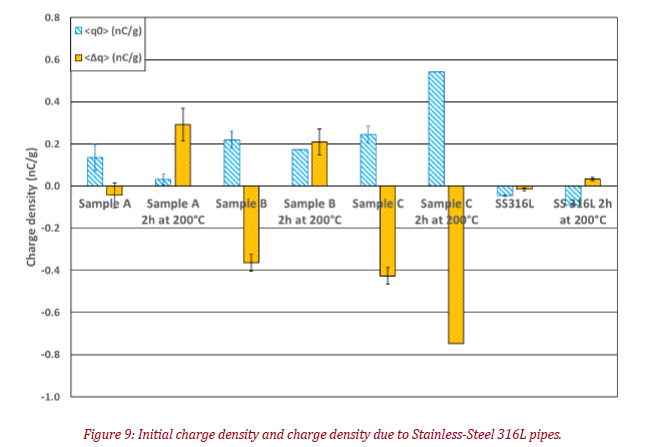
First of all, regarding virgin Aluminium alloys powders initial charges it is impossible to conclude due to error bars size. SS 316L has the lowest amount of initial charges, this is maybe due to the fact that this product has the highest PSD.
However, after a flow in contact with Stainless-Steel 316L pipes sample A acquire a lowest amount of charges, in comparison with powder B and C which highlight similar trends. Additionally, if a SS 316L powder is rubbed against a SS 316L a charge density close to 0 is observed (cf. triboelectric series).
After a thermal stress of 200°C for 2 hours, powders behaviour becomes highly interesting. Indeed, for sample A and B initial charges decrease and final charge change from negative to positive. Nonetheless, product B is still more charged than A. For sample C, the trend is conserved (positive initial charge and final charge after a flow), but the amount of charges is increased after the thermal degradation. Finally, SS 316L powder has a slightly highest amount of initial charges, and its charge density variation becomes positive (but remains low, i.e. 0.033nC/g).
Conclusion
- In this paper we have investigated the effect of thermal degradation on the collective behaviour of several Aluminium alloys (AlSi10Mg) and a Stainless-Steel 316L powder. The virgin powders were studied under ambient air and after 2 hours at 200°C.
- Three instruments were used: the GranuDrum for spreadability assessment, the GranuPack for packing dynamic analysis and the GranuCharge to evaluate powder triboelectricity in contact with Stainless-Steel 316L pipes.
- It has been shown that working with a powder at high temperature improves the product spreadability, this effect seems to be more important for powders with high specific area and for a material with a high thermal conductivity.
- These results were confirmed by the GranuPack, where we can see an improvement of the Hausner ratio for every powder (except sample A, due to error bars size) after the thermal stress process.
- However, judging by the packing parameter (n1/2), no clear trends were obtained, since some product highlights an improvement in terms of packing speed, and others have the opposite effect (like sample B and C).
- Finally, looking at the initial charge was highly interesting, because some products were highly impacted by the thermal degradation process, since their charge sign was changed. The differences between the Aluminium alloys and Stainless-Steel 316L powder was also easy to highlight, since SS 316L sample was not highly charged after a flow in contact with SS 316L pipes.
References
Cascade of granular flows for characterizing segregation, G. Lumay, F. Boschin, R. Cloots, N. Vandewalle, Powder Technology 234, 32-36 (2013).
Combined effect of moisture and electrostatic charges on powder flow, A. Rescaglio, J. Schockmel, N. Vandewalle and G. Lumay, EPJ Web of Conferences 140, 13009 (2017).
Compaction dynamics of a magnetized powder, G. Lumay, S. Dorbolo and N. Vandewalle, Physical Review E 80, 041302 (2009).
Compaction of anisotropic granular materials: Experiments and simulations, G. Lumay and N. Vandewalle, Physical Review E 70, 051314 (2004).
Compaction Dynamics of Wet Granular Assemblies, J. E. Fiscina, G. Lumay, F. Ludewig and N. Vandewalle, Physical Review Letters 105, 048001 (2010).
Effect of an electric field on an intermittent granular flow, E. Mersch, G. Lumay, F. Boschini, and N. Vandewalle, Physical Review E 81, 041309 (2010).
Effect of relative air humidity on the flowability of lactose powders, G. Lumay, K. Traina, F. Boschini, V. Delaval, A. Rescaglio, R. Cloots and N. Vandewalle, Journal of Drug Delivery Science and Technology 35, 207-212 (2016).
Experimental Study of Granular Compaction Dynamics at Different Scales: Grain Mobility, Hexagonal Domains, and Packing Fraction, G. Lumay and N. Vandewalle, Physical Review Letters 95, 028002 (2005).
Flow abilities of powders and granular materials evidenced from dynamical tap density measurement, K. Traina, R. Cloots, S. Bontempi, G. Lumay, N. Vandewalle and F. Boschini, Powder Technology, 235, 842-852 (2013).
Flow of magnetized grains in a rotating drum, G. Lumay and N. Vandewalle, Physical Review E 82, 040301(R) (2010).
How tribo-electric charges modify powder flowability, A. Rescaglio, J. Schockmel, F. Francqui, N. Vandewalle, and G. Lumay, Annual Transactions of The Nordic Rheology Society 25, 17-21 (2016).
Influence of cohesives forces on the macroscopic properties of granular assemblies, G. Lumay, J. Fiscina, F. Ludewig and N. Vandewalle, AIP Conference Proceedings 1542, 995 (2013).
Linking compaction dynamics to the flow properties of powders, G. Lumay, N. Vandewalle, C. Bodson, L. Delattre and O. Gerasimov, Applied Physics Letters 89, 093505 (2006).
Linking flowability and granulometry of lactose powders, F. Boschini, V. Delaval, K. Traina, N. Vandewalle, and G. Lumay, International Journal of Pharmaceutics 494, 312–320 (2015).
Measuring the flowing properties of powders and grains, G. Lumay, F. Boschini, K. Traina, S. Bontempi, J.-C. Remy, R. Cloots, and N. Vandewalle, Powder Technology 224, 19-27 (2012).
Motion of carbon nanotubes in a rotating drum: The dynamic angle of repose and a bed behavior diagram, S. L. Pirard, G. Lumay, N. Vandewalle, J-P. Pirard, Chemical Engineering Journal 146, 143-147 (2009).
Mullite coatings on ceramic substrates: Stabilisation of Al2O3–SiO2 suspensions for spray drying of composite granules suitable for reactive plasma spraying, A. Schrijnemakers, S. André, G. Lumay, N. Vandewalle, F. Boschini, R. Cloots and B. Vertruyen, Journal of the European Ceramic Society 29, 2169–2175 (2009).
Rheological behavior of β-Ti and NiTi powders produced by atomization for SLM production of open porous orthopedic implants, G. Yablokova, M. Speirs, J. Van Humbeeck, J.-P. Kruth, J. Schrooten, R. Cloots, F. Boschini, G. Lumay, J. Luyten, Powder Technology 283, 199–209 (2015).
The flow rate of granular materials through an orifice, C. Mankoc, A. Janda, R. Arévalo, J. M. Pastor, I. Zuriguel, A. Garcimartín and D. Maza, Granular Matter 9, p407–414 (2007).
The influence of grain shape, friction and cohesion on granular compaction dynamics, N. Vandewalle, G. Lumay, O. Gerasimov and F. Ludewig, The European Physical Journal E (2007).

